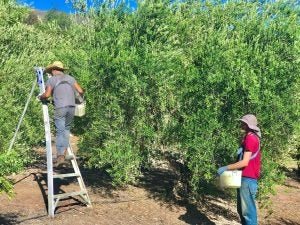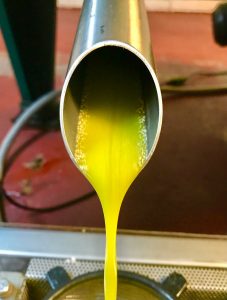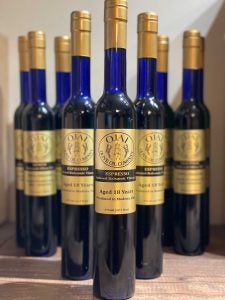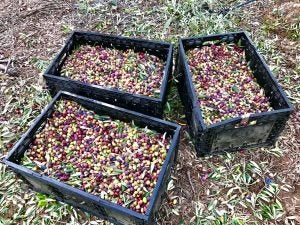Ojai Olive Oil focuses on sustainability and self-sufficiency in producing its premium products
The use of olive oil dates back thousands of years. Ancient Greeks produced olive oil for everyday use like lamp fuel, perfumes, and soap. They used olive oil to anoint kings, and exporters thrived by exporting premium olive oil out of Mycenaean Greece. But it wasn’t until the 18th century that Spaniards brought the ancient art of olive oil production to the United States — planting multiple groves of olive trees south of San Francisco, California.
According to the American Olive Oil Producers Association, U.S. olive oil millers produce just 5 percent of the olive oil consumed by Americans each year. And that 5 percent comes from approximately 40,000 acres of olive trees planted exclusively to produce olive oil in seven states: Arizona, Georgia, Hawaii, Oregon, Texas, Florida, and California.
For Phil Asquith, growing up on his family’s farm among olive groves in California’s Ojai Valley cultivated his love for olive oil production. Today, as the master miller and CEO of Ojai Olive Oil — a small-batch olive oil company — Asquith carries on his father’s legacy by continuing to perfect the olive oil production process. From hand-harvesting olives and using organic compost teas for fertilization to the use of a custom-built mill brought over from Tuscany, Italy, Asquith focuses on sustainability and self-sufficiency in producing the extra virgin olive oil.
The olive grove
Olive trees live a long time. In a 2014 article in Smithsonian Magazine, a reporter wrote about an olive tree in Bethlehem that could be 4,000 to 5,000 years old.
“Olive trees will procure fruit from when they are very young and all of their life,” said Asquith. “Many trees stop fruition after 50-100 years, but olives will continue giving fruit for thousands of years.”
The first olive trees on Asquith’s farm in the Ojai Valley of California were a Spanish varietal called Lechin de Sevilla planted by a Danish family in the 1800s. These 150-year-old heritage trees produced olives ideal for making olive oil, but the oil was too intense for most Americans. So Asquith’s father — Ronald Asquith — planted groves of milder varietals like Columellas, a French one that produces a sweet and fruity oil.
“We grow about a dozen different varieties of olives, but there are hundreds out there,” Asquith said. “As with grapes and wine, different olives will give different flavors in the resultant olive oil. Some can be more fruity and buttery, some more peppery and grassy. Regardless of variety though, they all ripen in the late fall-early winter.”
In California, that’s October through December for their harvest season.
Harvesting olives
Knowing when to harvest olives for olive oil production is something olive growers such as Asquith have perfected over time. Fruit maturation depends largely on things like olive variety, irrigation, and sunlight.
For example, a hot fall can cause olives to ripen quicker, which can narrow the time for optimal picking. And some varietals ripen faster than others, and olives can mature later than others in the grove. Olive growers get to know their olive trees over time and from experience know when each varietal is ready to harvest.

While most olive farmers pick olives with machines, Asquith and his harvesting crew still pick their olives largely by hand. This allows the crew to be more selective in what fruit they harvest. And it ensures they pick olives at the same rate they process them to keep the time from the tree to the mill at a minimum.
“Our trees are spread across slopes, on uneven terrain, so the machines wouldn’t work,” Asquith said. “We get a boost in some sections by using mechanized ‘wands’, that help knock the olives off the tree. We lay jets underneath to catch them as they fall.”
Asquith said less time from the tree to the mill makes the best possible olive oil.
After his crew harvests the olives, they carry them to a barn (within hours of the harvest) and pour the olives into the olive mill.
Milling olives
To mill olives at Ojai Olive Oil, Asquith uses a custom-made mill from Tuscany that came from a small family south of Florence. It’s a smaller mill, relatively speaking, but since the farm operates in small batches, it works.
At the farm, Asquith can produce about 250 gallons of olive oil a day, and on average, one olive season could yield about 3,000 gallons of olive oil with the mill running about 20 days a year.
The first thing millers do when the harvest arrives is place the olives into a hopper for cleaning. This ensures the olives are free of debris like dirt and twigs. Next, the olives go into a crusher (like a big blender) to be pulverized — pits and all — mashing them into a purple paste within seconds.

Next, the olive paste goes into mixers called malaxers (like big mixing bowls with slow blades) that mix the paste for about 30 minutes. This allows the little drops of oil that are freed up from breaking open the fruit to separate themselves.
The last step is putting the olives into a centrifuge that spins and uses centrifugal force to separate the oil from all the rest.
“As the olive oil is the lightest element of the mixture, it comes off the top,” said Asquith. “The oil gets collected into stainless steel drums, and the remaining paste is pumped into large piles.”
After the olive oil is collected, it sits for a couple of weeks before being decanted to passively filter out sediment and give the oil more shelf life and clarity.
This is where the term “first press” comes from that you see on olive oil bottles. The first pressing of the olives produces the best olive oil.

After a few rounds of decanting (gradually pouring the oil from one container to another) done over four to six weeks, it is ready to be blended, bottled in cobalt blue bottles, and labeled, which is all done onsite at the farm.
In the meantime, unlike larger operations, where millers run the leftover olive paste through the mill a second time, Asquith and his crew use that leftover paste (made of the pits, skins, and crushed fruit of the olives) as compost.
Making and using compost tea for fertilization
Asquith believes the best olives come from healthy trees and that the healthiest trees live as part of a strong and vibrant ecosystem — involving not just the crop you’re cultivating, but also all the surrounding plants, animals, and insects.
“To have a healthy crop you need a healthy ecosystem,” said Asquith. “We spend more time on things like the health of the soil, the bees, the water retention, bringing in animals for grazing, than we do caring for just our olive trees. Regenerative agriculture is critical to our long-term survival.”

One way Asquith fertilizes the olive grove is by making an organic compost tea from the paste left over from the olive oil-making process.
Asquith mixes the leftover paste with olive leaves, branches, pieces of native plants around the property, aquatic plants from their ponds, and existing dirt from the base of the oldest and healthiest olive trees. This gives him a nice mix with microbial life. When the compost is mature, Asquith puts sections of the compost into big cheesecloth bags, puts it in water and pumps it with oxygen. Then, adds sugar.
“The combination causes the microbial life to multiply exponentially, and all the nutrients just seep out into the liquid like a giant batch of tea,” explained Asquith on an In the Weeds podcast episode. That tea is then pumped through the irrigation lines to the entire grove.
“It’s a living fertilizer that you have to use within about six hours of making it,” Asquith added. “You can’t buy it or transfer it. It’s free and it’s the best fertilizer.”
Olive farming
For olive farming one of the biggest challenges is water. While olives need little water compared to most crops, farmers still need to irrigate. When Asquith sees little rain in a season, it’s hard on the trees and that can lead to less crop.
Another challenge olive farmers face is not knowing when olive trees will produce olives. They see good years and bad years. A good year yields a lot of olives. A bad year could yield nothing — which is the natural cyclical nature of fruits and nuts.

To ensure the farm has enough olives to produce olive oil each year, Asquith partners with other local olive farmers.
Asquith added that farming can be a lot of work for very little profit, but that’s not always the case. “Specialty foods can have a great market, and there is increasing demand for very high quality and top-level ethical and sustainable production.”
Olive oil fans can visit the farm for tastings and or tours seven days a week. Asquith’s best-selling olive oil is the Provençale extra virgin olive oil.
“It’s very sweet, mild and fruity,” he said. “Which makes it good for just about anything.”
Suzanne Downing is an outdoor writer and photographer in Montana with an environmental science journalism background. Her work can be found in Outdoors Unlimited, Bugle Magazine, Missoulian, Byline Magazine, Communique, MTPR online, UM Native News, National Wildlife Federation campaigns and more.



